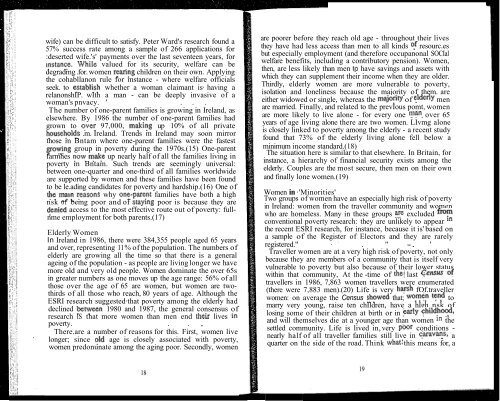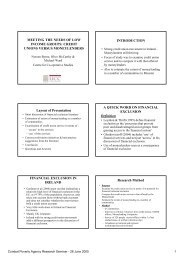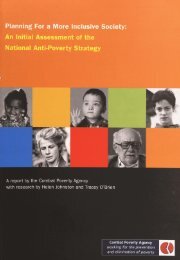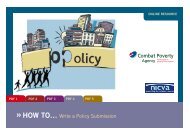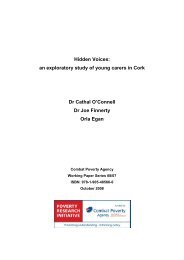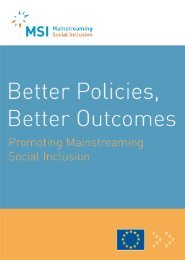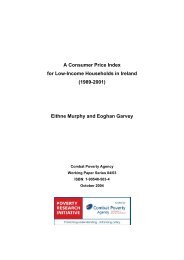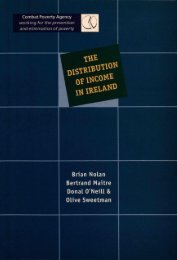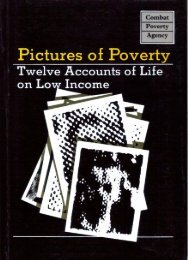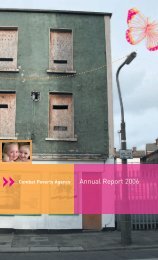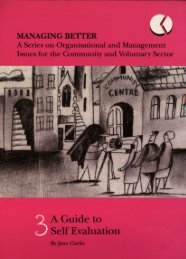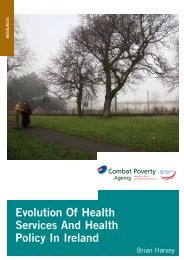Women and Poverty (1989) - Combat Poverty Agency
Women and Poverty (1989) - Combat Poverty Agency
Women and Poverty (1989) - Combat Poverty Agency
You also want an ePaper? Increase the reach of your titles
YUMPU automatically turns print PDFs into web optimized ePapers that Google loves.
on hish women also forces us to rely in places on evidence<br />
from other countries. . . .<br />
The Measurement of<strong>Poverty</strong> <strong>and</strong> <strong>Women</strong><br />
Placing the focus on women means that we must look<br />
critically at how existing research has· treated women.<br />
Research can conceal as well as reveal. Most poverty research<br />
has shortcomings in how it has measured poverty among<br />
women. Conventional research on poverty has usually<br />
assumed that income is distributed equally within the home.<br />
~o the research has.based its measures of poverty on the<br />
mcome of collective or aggregate units such as families <strong>and</strong><br />
households. This ignores both the possibility that income is<br />
unequally shared. <strong>and</strong> women's lack of control over the<br />
family's income. <strong>Women</strong>, therefore, <strong>and</strong> perhaps children<br />
also, are likely to be undercounted in poverty figures that are<br />
based on household or family income. Research based on<br />
household or family income accepts that there are no poor<br />
people in households or families with incomes above the<br />
poverty line <strong>and</strong> that all members of families are equally poor<br />
or rich. Such assumptions are unjustifiable in the absence of<br />
evidence to prove that they are correct.<br />
Where possible throughout this book, women living on low<br />
incomes speak for themselves, sometimes through their<br />
writings <strong>and</strong> poems. This kind ofinformation is as important,<br />
<strong>and</strong> in some cases more important, as statistical information.<br />
<strong>Women</strong>'s own experience of poverty is the main focus of<br />
interest throughout this book~ .<br />
everyday lives, their hopes, fears <strong>and</strong> expectations.<br />
Chapter 3 takes work as the focus <strong>and</strong> looks at how women<br />
fare with regard to paid work <strong>and</strong> unpaid work .<strong>and</strong> how they<br />
have been affected by recent developments m the labour<br />
market. .. d· Ch<br />
Social welfare's treatment of women ~sexamme m apter<br />
4, particularly for its ~ffect on women s long-term chances of<br />
remaining in or escapmg from poverty. .<br />
In Chapter 5 the foc~s is on. women's acces~· to pubhc<br />
services mainly education, housmg <strong>and</strong> legal services..<br />
Chapter'6 looks at the relationship between women's health<br />
<strong>and</strong> poverty. ... .<br />
Chapter 7 examines some local actions that have been taken<br />
to improve women's sit~atio~, especially· attempts by wo!"en<br />
to organise themselves m therr ~ocal· are.a~..The purpose IS to<br />
evaluate the potential of educational actiVIties among women<br />
at local level for bringing about change. . . ...<br />
Chapter 8 looks to !he future <strong>and</strong> identi~es· the posslblhues<br />
<strong>and</strong> priorities for action to address women s poverty. .<br />
The Framework for the Book<br />
The main dimensions of women's poverty provide the book's<br />
structure. The book consists of three parts: the first<br />
descriptive; the second explanatory; the third suggested<br />
changes. . .<br />
Chapter 1 presents <strong>and</strong> examines the most up to date evidence<br />
available on poverty in Irel<strong>and</strong>. <strong>Women</strong>'s poverty is the main<br />
focus <strong>and</strong> the characteristics of groups of very poor women<br />
are examined in detail.<br />
Chapter 2 puts flesh on these statistics: it describes, sometimes<br />
in women's ownwords, what it is like to live one's life<br />
in very poor conditions. We get a feeling .for women's<br />
10<br />
11


